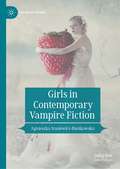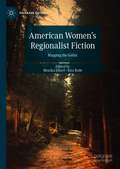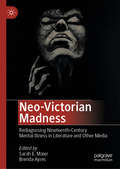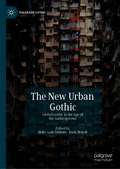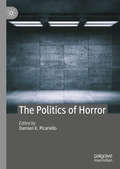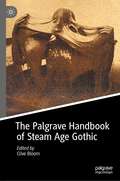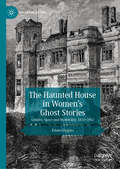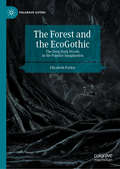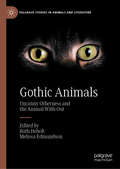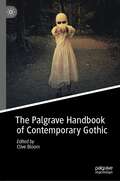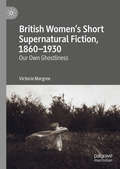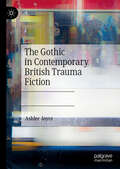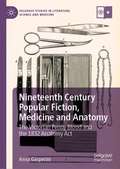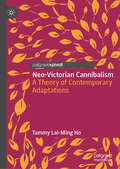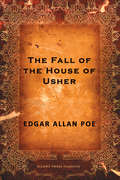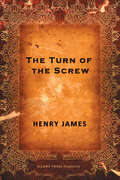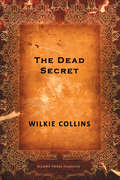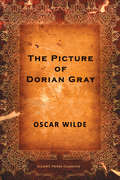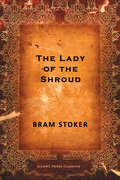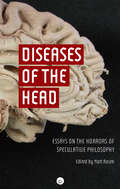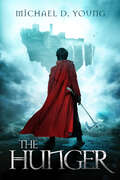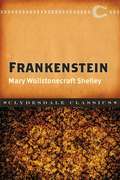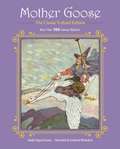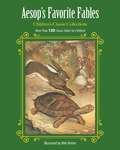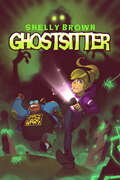- Table View
- List View
Girls in Contemporary Vampire Fiction (Palgrave Gothic)
by Agnieszka Stasiewicz-BieńkowskaThis book explores the narratives of girlhood in contemporary YA vampire fiction, bringing into the spotlight the genre’s radical, ambivalent, and contradictory visions of young femininity. Agnieszka Stasiewicz-Bieńkowska considers less-explored popular vampire series for girls, particularly those by P.C. and Kristin Cast and Richelle Mead, tracing the ways in which they engage in larger cultural conversations on girlhood in the Western world. Mapping the interactions between girl and vampire corporealities, delving into the unconventional tales of vampire romance and girl sexual expressions, examining the narratives of women and violence, and venturing into the uncanny vampire classroom to unmask its critique of present-day schooling, the volume offers a new perspective on the vampire genre and an engaging insight into the complexities of growing up a girl.
American Women's Regionalist Fiction: Mapping the Gothic (Palgrave Gothic)
by Monika Elbert Rita BodeAmerican Women’s Regionalist Fiction: Mapping the Gothic seeks to redress the monolithic vision of American Gothic by analyzing the various sectional or regional attempts to Gothicize what is most claustrophobic or peculiar about local history. Since women writers were often relegated to inferior status, it is especially compelling to look at women from the Gothic perspective. The regionalist Gothic develops along the line of difference and not unity—thus emphasizing regional peculiarities or a sense of superiority in terms of regional history, natural landscapes, immigrant customs, folk tales, or idiosyncratic ways. The essays study the uncanny or the haunting quality of “the commonplace,” as Hawthorne would have it in his introduction to The House of the Seven Gables, in regionalist Gothic fiction by a wide range of women writers between ca. 1850 and 1930. This collection seeks to examine how/if the regionalist perspective is small, limited, and stultifying and leads to Gothic moments, or whether the intersection between local and national leads to a clash that is jarring and Gothic in nature.
Neo-Victorian Madness: Rediagnosing Nineteenth-Century Mental Illness in Literature and Other Media
by Sarah E. Maier Brenda AyresNeo-Victorian Madness: Rediagnosing Nineteenth-Century Mental Illness in Literature and Other Media investigates contemporary fiction, cinema and television shows set in the Victorian period that depict mad murderers, lunatic doctors, social dis/ease and madhouses as if many Victorians were “mad.” Such portraits demand a “rediagnosing” of mental illness that was often reduced to only female hysteria or a general malaise in nineteenth-century renditions. This collection of essays explores questions of neo-Victorian representations of moral insanity, mental illness, disturbed psyches or non-normative imaginings as well as considers the important issues of legal righteousness, social responsibility or methods of restraint and corrupt incarcerations. The chapters investigate the self-conscious re-visions, legacies and lessons of nineteenth-century discourses of madness and/or those persons presumed mad rediagnosed by present-day (neo-Victorian) representations informed by post-nineteenth-century psychological insights.
The New Urban Gothic: Global Gothic in the Age of the Anthropocene (Palgrave Gothic)
by Ruth Heholt Holly-Gale MilletteThis collection explores global dystopic, grotesque and retold narratives of degeneration, ecological and economic ruin, dystopia, and inequality in contemporary fictions set in the urban space. Divided into three sections—Identities and Histories, Ruin and Residue, and Global Gothic—The New Urban Gothic explores our anxieties and preoccupation with social inequalities, precarity and the peripheral that are found in so many new fictions across various media. Focusing on non-canonical Gothic global cities, this distinctive collection discusses urban centres in England’s Black Country, Moscow, Detroit, Seoul, Hong Kong, Bangkok, Singapore, Dehli, Srinigar, Shanghai and Barcelona as well as cities of the imaginary, the digital and the animated. This book will appeal to anyone interested in the intersections of time, place, space and media in contemporary Gothic Studies. The New Urban Gothic casts reflections and shadows on the age of the Anthropocene.
The Politics of Horror
by Damien K. PicarielloThe Politics of Horror features contributions from scholars in a variety of fields—political science, English, communication studies, and others—that explore the connections between horror and politics. How might resources drawn from the study of politics inform our readings of, and conversations about, horror? In what ways might horror provide a useful lens through which to consider enduring questions in politics and political thought? And what insights might be drawn from horror as we consider contemporary political issues? In turning to horror, the contributors to this volume offer fresh provocations to inform a broad range of discussions of politics.
The Palgrave Handbook of Steam Age Gothic
by Clive BloomBy the early 1830s the old school of Gothic literature was exhausted. Late Romanticism, emphasising as it did the uncertainties of personality and imagination, gave it a new lease of life. Gothic—the literature of disturbance and uncertainty—now produced works that reflected domestic fears, sexual crimes, drug filled hallucinations, the terrible secrets of middle class marriage, imperial horror at alien invasion, occult demonism and the insanity of psychopaths. It was from the 1830s onwards that the old gothic castle gave way to the country house drawing room, the dungeon was displaced by the sewers of the city and the villains of early novels became the familiar figures of Dr Jekyll and Mr Hyde, Dracula, Dorian Grey and Jack the Ripper. After the death of Prince Albert (1861), the Gothic became darker, more morbid, obsessed with demonic lovers, blood sucking ghouls, blood stained murderers and deranged doctors. Whilst the gothic architecture of the Houses of Parliament and the new Puginesque churches upheld a Victorian ideal of sobriety, Christianity and imperial destiny, Gothic literature filed these new spaces with a dread that spread like a plague to America, France, Germany and even Russia. From 1830 to 1914, the period covered by this volume, we saw the emergence of the greats of Gothic literature and the supernatural from Edgar Allan Poe to Emily Bronte, from Sheridan Le Fanu to Bram Stoker and Robert Louis Stevenson. Contributors also examine the fin-de-siècle dreamers of decadence such as Arthur Machen, M P Shiel and Vernon Lee and their obsession with the occult, folklore, spiritualism, revenants, ghostly apparitions and cosmic annihilation. This volume explores the period through the prism of architectural history, urban studies, feminism, 'hauntology' and much more. 'Horror', as Poe teaches us, 'is the soul of the plot'.
The Haunted House in Women’s Ghost Stories: Gender, Space and Modernity, 1850–1945 (Palgrave Gothic)
by Emma LigginsThis book explores Victorian and modernist haunted houses in female-authored ghost stories as representations of the architectural uncanny. It reconsiders the gendering of the supernatural in terms of unease, denial, disorientation, confinement and claustrophobia within domestic space. Drawing on spatial theory by Gaston Bachelard, Henri Lefebvre and Elizabeth Grosz, it analyses the reoccupation and appropriation of space by ghosts, women and servants as a means of addressing the opposition between the past and modernity. The chapters consider a range of haunted spaces, including ancestral mansions, ghostly gardens, suburban villas, Italian churches and houses subject to demolition and ruin. The ghost stories are read in the light of women’s non-fictional writing on architecture, travel, interior design, sacred space, technology, the ideal home and the servant problem. Women writers discussed include Elizabeth Gaskell, Margaret Oliphant, Vernon Lee, Edith Wharton, May Sinclair and Elizabeth Bowen. This book will appeal to students and researchers in the ghost story, Female Gothic and Victorian and modernist women’s writing, as well as general readers with an interest in the supernatural.
The Forest and the EcoGothic: The Deep Dark Woods in the Popular Imagination (Palgrave Gothic)
by Elizabeth ParkerThis book offers the first full length study on the pervasive archetype of The Gothic Forest in Western culture. The idea of the forest as deep, dark, and dangerous has an extensive history and continues to resonate throughout contemporary popular culture. The Forest and the EcoGothic examines both why we fear the forest and how exactly these fears manifest in our stories. It draws on and furthers the nascent field of the ecoGothic, which seeks to explore the intersections between ecocriticism and Gothic studies. In the age of the Anthropocene, this work importantly interrogates our relationship to and understandings of the more-than-human world. This work introduces the trope of the Gothic forest, as well as important critical contexts for its discussion, and examines the three main ways in which this trope manifests: as a living, animated threat; as a traditional habitat for monsters; and as a dangerous site for human settlement. This book will appeal to students and scholars with interests in horror and the Gothic, ecohorror and the ecoGothic, environmentalism, ecocriticism, and popular culture more broadly. The accessibility of the subject of ‘The Deep Dark Woods’, coupled with increasingly mainstream interests in interactions between humanity and nature, means this work will also be of keen interest to the general public.
Gothic Animals: Uncanny Otherness and the Animal With-Out (Palgrave Studies in Animals and Literature)
by Melissa Edmundson Ruth HeholtThis book begins with the assumption that the presence of non-human creatures causes an always-already uncanny rift in human assumptions about reality. Exploring the dark side of animal nature and the ‘otherness’ of animals as viewed by humans, and employing cutting-edge theory on non-human animals, eco-criticism, literary and cultural theory, this book takes the Gothic genre into new territory. After the dissemination of Darwin’s theories of evolution, nineteenth-century fiction quickly picked up on the idea of the ‘animal within’. Here, the fear explored was of an unruly, defiant, degenerate and entirely amoral animality lying (mostly) dormant within all of us. However, non-humans and humans have other sorts of encounters, too, and even before Darwin, humans have often had an uneasy relationship with animals, which, as Donna Haraway puts it, have a way of ‘looking back’ at us. In this book, the focus is not on the ‘animal within’ but rather on the animal ‘with-out’: other and entirely incomprehensible.
The Palgrave Handbook of Contemporary Gothic
by Clive Bloom“Simply put, there is absolutely nothing on the market with the range of ambition of this strikingly eclectic collection of essays. Not only is it impossible to imagine a more comprehensive view of the subject, most readers – even specialists in the subject – will find that there are elements of the Gothic genre here of which they were previously unaware.” - Barry Forshaw, Author of British Gothic Cinema and Sex and Film The Palgrave Handbook of Contemporary Gothic is the most comprehensive compendium of analytic essays on the modern Gothic now available, covering the vast and highly significant period from 1918 to 2019. The Gothic sensibility, over 200 years old, embraces its dark past whilst anticipating the future. From demons and monsters to post- apocalyptic fears and ecological fantasies, Gothic is thriving as never before in the arts and in popular culture. This volume is made up of 62 comprehensive chapters with notes and extended bibliographies contributed by scholars from around the world. The chapters are written not only for those engaged in academic research but also to be accessible to students and dedicated followers of the genre. Each chapter is packed with analysis of the Gothic in both theory and practice, as the genre has mutated and spread over the last hundred years. Starting in 1918 with the impact of film on the genre's development, and moving through its many and varied international incarnations, each chapter chronicles the history of the gothic milieu from the movies to gaming platforms and internet memes, television and theatre. The volume also looks at how Gothic intersects with fashion, music and popular culture: a multi-layered, multi-ethnic, even a trans-gendered experience as we move into the twenty first century.
British Women’s Short Supernatural Fiction, 1860–1930: Our Own Ghostliness
by Victoria MargreeThis book explores women’s short supernatural fiction between the emergence of first wave feminism and the post-suffrage period, arguing that while literary ghosts enabled an interrogation of women’s changing circumstances, ghosts could have both subversive and conservative implications. Haunted house narratives by Charlotte Riddell and Margaret Oliphant become troubled by uncanny reminders of the origins of middle-class wealth in domestic and foreign exploitation. Corpse-like revenants are deployed in Female Gothic tales by Mary Elizabeth Braddon and Edith Nesbit to interrogate masculine aestheticisation of female death. In the culturally-hybrid supernaturalism of Alice Perrin, the ‘Marriage Question’ migrates to colonial India, and psychoanalytically-informed stories by May Sinclair, Eleanor Scott and Violet Hunt explore just how far gender relations have really progressed in the post-First World War period. Study of the woman’s short story productively problematises literary histories about the “golden age” of the ghost story, and about the transition from Victorianism to modernism.
The Gothic in Contemporary British Trauma Fiction
by Ashlee JoyceThis book examines the intersection of trauma and the Gothic in six contemporary British novels: Martin Amis’s London Fields, Margaret Drabble’s The Gates of Ivory, Ian McEwan’s Atonement, Pat Barker’s Regeneration and Double Vision, and Kazuo Ishiguro’s Never Let Me Go. In these works, the Gothic functions both as an expression of societal violence at the turn of the twenty-first century and as a response to the related crisis of representation brought about by the contemporary individual’s highly mediated and spectatorial relationship to this violence. By locating these six novels within the Gothic tradition, this work argues that each text, to borrow a term from Jacques Derrida, “participates” in the Gothic in ways that both uphold the paradigm of “unspeakability” that has come to dominate much trauma fiction, as well as push its boundaries to complicate how we think of the ethical relationship between witnessing and writing trauma.
Nineteenth Century Popular Fiction, Medicine and Anatomy: The Victorian Penny Blood and the 1832 Anatomy Act (Palgrave Studies in Literature, Science and Medicine)
by Anna GasperiniThis book investigates the relationship between the fascinating and misunderstood penny blood, early Victorian popular fiction for the working class, and Victorian anatomy. In 1832, the controversial Anatomy Act sanctioned the use of the body of the pauper for teaching dissection to medical students, deeply affecting the Victorian poor. The ensuing decade, such famous penny bloods as Manuscripts from the Diary of a Physician, Varney the Vampyre, Sweeney Todd, and The Mysteries of London addressed issues of medical ethics, social power, and bodily agency. Challenging traditional views of penny bloods as a lowlier, un-readable genre, this book rereads these four narratives in the light of the 1832 Anatomy Act, putting them in dialogue with different popular artistic forms and literary genres, as well as with the spaces of death and dissection in Victorian London, exploring their role as channels for circulating discourses about anatomy and ethics among the Victorian poor.
Neo-Victorian Cannibalism: A Theory of Contemporary Adaptations
by Tammy Lai-Ming HoThis Pivot examines a body of contemporary neo-Victorian novels whose uneasy relationship with the past can be theorised in terms of aggressive eating, including cannibalism. Not only is the imagery of eating repeatedly used by critics to comprehend neo-Victorian literature, the theme of cannibalism itself also appears overtly or implicitly in a number of the novels and their Victorian prototypes, thereby mirroring the cannibalistic relationship between the contemporary and the Victorian. Tammy Lai-Ming Ho argues that aggressive eating or cannibalism can be seen as a pathological and defining characteristic of neo-Victorian fiction, demonstrating how cannibalism provides a framework for understanding the genre’s origin, its conflicted, ambivalent and violent relationship with its Victorian predecessors and the grotesque and gothic effects that it generates in its fiction.
The Fall of the House of Usher
by Edgar Allan PoeThe fate of the Usher ancestral home rests on the heads of Roderick and Madeline Usher—siblings afflicted with psychological illnesses that will prove to be their undoing. A master of the mysterious and the macabre, Edgar Allan Poe's short stories explore the human psyche. "The Fall of the House of Usher" is considered to be one of the author's most famous works, and is a masterpiece of American Gothic literature.
The Turn of the Screw
by Henry JamesGiven charge of two young children, Flora and Miles, by their uncle, a young governess takes up their care at a house in the country. But the governess's pleasure in her young charges and in the idyllic countryside soon turns to fear and panic when she comes to suspect that the house is haunted. And when the children are revealed to be aware of the presence, the governess fears -quite rightly - for their safety as well. The Turn of the Screw, a part of gothic and ghost story genres, was originally published in 1898. Many critics have tried to determine the exact nature of the evil hinted at by the story. However, others have argued that the brilliance of the novella results from its ability to create an intimate sense of confusion and suspense within the reader.
The Dead Secret
by Wilkie CollinsWarned by a servant to avoid a particular room in her ancestral home, Porthgenna Tower, a wealthy heiress searches the room only to discover a long-held secret that has the potential to strip her of her inheritance. But when Rosamund Treverton reveals the secret of her birth, she is surprised by the reactions of those closest to her.
The Picture of Dorian Gray
by Oscar WildeDorian Gray believes that the true value of life is revealed only in the pursuit of beauty. As a result, Dorian sells his soul so that a beautiful painting of him will age, while he remains forever young.
The Lady of the Shroud
by Bram StokerThe Lady of the Shroud is a novel by Bram Stoker, published in 1909. The book is an epistolary novel, narrated in the first person via letters and diary extracts from various characters, but mainly Rupert. The initial sections, leading up to the reading of the uncle's will, told by other characters, suggest that Rupert is the black sheep of the family, and the conditions of having to live in the castle in the Blue Mountains for a year before he can permanently inherit the unexpectedly large million-pound estate suggest the uncle is somehow testing the heir. When an unexpected, mysterious women cloaked in a wet shroud appears, she changes Rupert's destiny forever.
Diseases of the Head: Essays on the Horrors of Speculative Philosophy
by Matt RosenDiseases of the Head is an anthology of essays from contemporary philosophers, artists, and writers working at the crossroads of speculative philosophy and speculative horror. At once a compendium of multivocal endeavors, a breviary of supposedly illicit ponderings, and a travelogue of philosophical exploration, this collection centers itself on the place at which philosophy and horror meet. Employing rigorous analysis, incisive experimentation, and novel invention, this anthology asks about the use that speculation can make of horror and horror of speculation, about whether philosophy is fictional or fiction philosophical, and about the relationship between horror, the exigencies of our world and time, and the future developments that may await us in philosophy itself. From philosophers working on horrific themes, to horror writers influenced by heresies in the wake of post-Kantianism, to artists engaged in projects that address monstrosity and alienation, Diseases of the Head aims at nothing less than a speculative coup d'état. Refusing both total negation and absolute affirmation, refusing to deny everything or account for everything, refusing the posture of critique and the posture of all-encompassing unification, this collection of essays aims at exposition and construction, analysis and creation – it desires to fight for some thing, but not everything, and not nothing. And it desires, most of all, to speak from the position of its own insufficiency, its own partiality, its own under-determinacy, which is always indicative of the practice of thinking, of speculation. Considering themes of anonymity, otherness and alterity, the gothic, extinction and the world without us, the end times, the apocalypse, the ancient and the world before us, and the uncanny or unheimlich, among other motifs, this anthology seeks to articulate the cutting edge which can be found at the intersection of speculative philosophy and speculative horror.
The Hunger
by Michael D. YoungAzil leads a quiet, scholary life until a failed assassination attempt and a mysterious stranger push him into a quest to fulfill a world-saving prophecy. Fans of high fantasy will be enthralled by volatile magic, clan politics, and a reluctant adventurer&’s journey through a land ruled by hunger.
Frankenstein: Or The Modern Prometheus
by Mary Shelley"Enduring power.” -The New York TimesPackaged in handsome and affordable trade editions, Clydesdale Classics is a new series of essential literary works. The series features literary phenomena with influence and themes so great that, after their publication, they changed literature forever. From the musings of literary geniuses such as Mark Twain in The Adventures of Huckleberry Finn, to the striking personal narratives from Harriet Jacobs in Incidents in the Life of a Slave Girl, this new series is a comprehensive collection of our literary history through the words of the exceptional few.Frankenstein, or The Modern Prometheus, is often referred to as one the most important literary works of all time. Having been adapted and reprinted thousands of times, and often cited as the birth of the gothic novel and the science fiction genre, Frankenstein has captivated readers for centuries. It is the haunting tale of Victor Frankenstein, a young scientist who creates a grotesque and cognizant being through a scientific experiment. "The monster,” as it’s frequently referred to throughout the novel, consists of sewn body parts from multiple cadavers being used for scientific research. On a dark, stormy night, the creature is brought to life by being shocked with an electrical current harnessed from a lightning storm. The novel explores scientific practices such as galvanism, as well as the ethical repercussions of bringing the deceased back to life.With its grim, but gripping narrative, Frankenstein is the classic story of life and death, humanity and monstrosity, and blurring the lines in between.
Mother Goose: More Than 100 Famous Rhymes!
by Eulalie Osgood Grover Frederick RichardsonRacehorse Publishing’s Quintessential Children’s Classics series is a collection of timeless children’s literature. Handsomely packaged and affordable, this new series aims to revitalize these enchanting works, and continue the tradition of sharing them with the next generation of readers.Flash back to your childhood. We all remember hearing the remarkable, rhyming tales from a mystery woman known only by the name "Mother Goose.” Having been reprinted hundreds of times and passed down from generation to generation, Mother Goose’s stories are some of the most popular children’s poetry in the world.Originally made popular in the 17th century, these rhymes were on the forefront of fairy tale literature, and are often cited as the beginning of the genre. Now, these nursery rhymes are made available again in this stunning re-packaging of the classic Volland edition. This edition includes over one hundred and ten of Mother Goose’s most famous nursery rhymes, a foreword, and full color illustrations on every page by renowned illustrator Frederick Richardson.
Aesop's Favorite Fables: More Than 130 Classic Fables for Children!
by Milo WinterRacehorse Publishing’s Children’s Classic Collections is a new series that offers readers timeless compilations of children’s literature. Handsomely packaged and affordable, this new series aims to revitalize these enchanting works and continue the tradition of sharing them with the next generation.Passed down for thousands of years, Aesop’s Fables is a collection of moral stories by the famed storyteller from ancient Greece. Reprinted and translated thousands of times over the past two millennia, this collection represents some of the most widely known and famous children’s literature. Many of these fables bestow human traits upon animal characters and place them in human situations to highlight desirable and less desirable traits. Their intent, through the telling of these tales, is to teach readers important moral lessons such as "Self-help is the best help” or "Do not attempt too much all at once.”Accompanied by beautiful color illustrations by renowned illustrator Milo Winter, this premiere collection of Aesop’s Favorite Fables is sure to ignite young imaginations and educate readers about virtue, kindness, integrity, problem-solving, happiness, and what it means to be human.
Ghostsitter
by Shelly BrownJoin two ghost-seeing friends, Tiffany and Justin, as they strive to solve mysteries, fit in at school, and help troubled ghosts seeking peace in this thrilling middle grade adventure.
